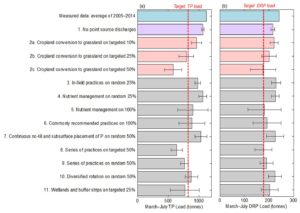– The recent resurgence of hypoxia and harmful algal blooms in Lake Erie, driven substantially by phosphorus loads from agriculture, have led the U.S. and Canada to begin developing plans to meet new phosphorus load targets. To provide insight into which agricultural management options could help reach these targets, we tested alternative agricultural land use and land management scenarios on phosphorus loads to Lake Erie. These scenarios highlight certain constraints on phosphorus load reductions from changes in the Maumee River Watershed (MRW), which contributes roughly half of the phosphorus load to the lake’s western basin.
We evaluated the effects on phosphorus loads under nutrient management strategies, reduction of fertilizer applications, employing vegetative buffers, and implementing widespread cover crops and alternative cropping changes. Results indicate that:
- there are multiple pathways to reach the 40% load reduction target, but extensive implementation of agricultural conservation practices are needed (see graph below)
- very much more even if fertilizer application ceased, it may take years to see desired decr
eases in phosphorus loads, especially if we experience greater spring precipitation or snowmelt - widespread conversions to perennial crops that may be used for biofuel production are capable of substantially
reducing phosphorus loads - a combination of legacy phosphorus, land management, land use, and climate should all be considered when seeking phosphorus loading solution

Kalcic, M., Kirchhoff, N. Bosch, R. L. Muenich, M. Murray, , J. Gardner. D. Scavia. 2016.Engaging stakeholders to define feasible and desirable agricultural conservation in western Lake Erie watersheds. Sci. Technol. in press DOI: 10.1021/acs.est.6b01421
Muenich, R.L., M. Kalcic, D. Scavia. 2016.Evaluating the impact of legacy P and agricultural conservation practices on nutrient loads from the Maumee River Watershed. Sci. Technol. in press DOI: 10.1021/acs.est.6b01420
Informing Lake Erie Agriculture Nutrient Management via Scenario Evaluation
A Multi-model approach to evaluating phosphorus target loads for Lake Erie (in review)